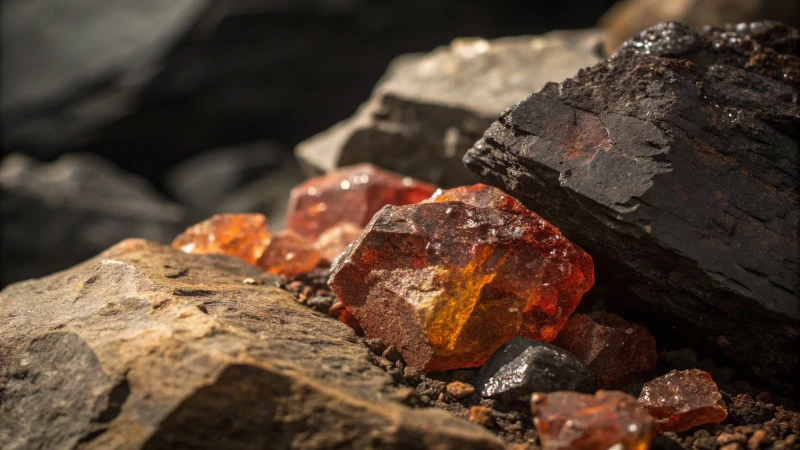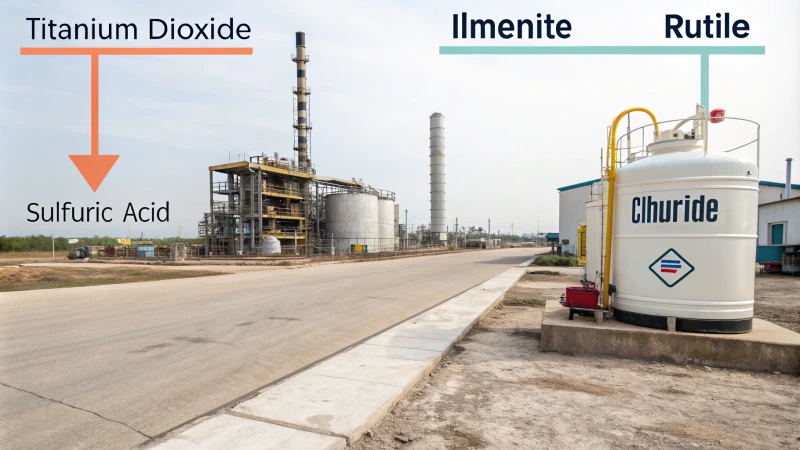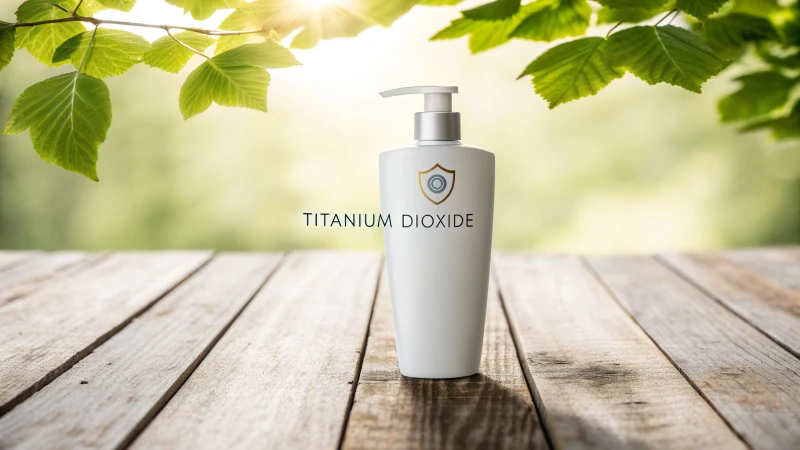
Interested in titanium dioxide and its origins? Learn a bit about my exploration with this intriguing substance.
Titanium dioxide (TiO₂) primarily comes from minerals like ilmenite and rutile. People process these minerals to obtain this important compound. Ilmenite and rutile exist in large amounts across the globe. They serve important functions in many products. This includes paints and food items.
I remember the first time I found titanium dioxide during my early days in the paint industry. This bright white pigment is really interesting. It comes mainly from minerals like ilmenite and rutile. These minerals are mined from the earth. Countries such as Australia and South Africa have large deposits of these minerals. It felt like discovering treasures that are important in everyday products. The extraction processes are very interesting too! These minerals change through methods like the sulfuric acid process. This process eventually turns them into the titanium dioxide used in paints, food and cosmetics. It's amazing. Something so important in our daily lives has a complex origin story!
Titanium dioxide is sourced from ilmenite and rutile minerals.True
Ilmenite and rutile are primary minerals used to extract titanium dioxide, confirming its source.
Titanium dioxide has no applications in food products.False
Contrary to this claim, titanium dioxide is widely used in food products for coloring and opacity.
What Are the Different Types of Titanium Dioxide?
Have you ever thought about how paints are so bright or why some sunscreens protect better? The secret is a tiny wonder called titanium dioxide! This ingredient is powerful. Let's look at the various kinds and find out their special wonders together.
Titanium dioxide comes in three main types꞉ rutile, anatase and brookite. Rutile stays stable. This form is used a lot in paints and plastics. It has a very high refractive index. Anatase is less stable but really good in photocatalysis and cosmetics. Brookite is rare. It has potential in research.

Understanding the Forms of Titanium Dioxide
Titanium dioxide (TiO₂) exists in several distinct forms, each with unique properties and applications. The three primary types are rutile, anatase, and brookite.
Rutile
Rutile is the most common and stable form of titanium dioxide. It is known for its high refractive index and excellent UV absorption capabilities. Rutile is widely used in:
- Paints and Coatings: Its whiteness and opacity make it ideal for providing coverage in various paints.
- Plastics: Rutile enhances the durability and weather resistance of plastic products.
Rutile is predominantly mined from ilmenite, making it a readily available option for manufacturers.
Anatase
Anatase has a tetragonal crystal structure and is less stable compared to rutile. Despite this, it is still valued for specific applications such as:
- Photocatalysis: Anatase is effective in breaking down pollutants under UV light, making it suitable for environmental applications.
- Cosmetics: Due to its fine particle size, anatase is used in various cosmetic products for a pearly finish.
While not as widely used in paints as rutile, its unique properties enable its application in niche markets.
Brookite
Brookite is the least common form of titanium dioxide and has limited industrial applications. However, it is of interest in research due to its unique crystalline structure.
- Potential Applications: There are ongoing studies exploring the use of brookite in advanced materials and coatings.
Although brookite is not commercially exploited at the same scale as rutile or anatase, its properties are a subject of scientific inquiry.
Comparative Table of Titanium Dioxide Forms
| Type | Structure | Stability | Main Applications | Properties |
|---|---|---|---|---|
| Rutile | Tetragonal | Stable | Paints, Plastics | High refractive index, UV absorbent |
| Anatase | Tetragonal | Less stable | Photocatalysis, Cosmetics | Effective under UV light, fine particle size |
| Brookite | Orthorhombic | Least stable | Research, Advanced materials | Unique structure, limited commercial use |
Conclusion: Industry Relevance
The distinct properties of these titanium dioxide forms lead to their varied applications across industries such as coatings, plastics, and cosmetics. Each type serves specific needs that are critical to product quality and performance. Understanding these differences helps manufacturers choose the right type for their applications, ensuring compliance with industry standards while optimizing cost and efficiency. For more insights on the practical uses and pricing of titanium dioxide, you may want to explore titanium dioxide market trends1.
Rutile is the most stable form of titanium dioxide.True
Rutile is known for its stability and high refractive index, making it widely used in paints and plastics.
Brookite is the most commonly used type of titanium dioxide.False
Brookite is the least common and has limited applications compared to rutile and anatase, which are more widely used.
How Is Titanium Dioxide Extracted from Its Natural Sources?
Have you ever thought about the source of the bright white color in your paint or sunscreen? The process of extracting titanium dioxide is fascinating. This mineral follows an interesting path before it ends up in products. This journey from mineral to practical use is really exciting.
Titanium dioxide comes mostly from ilmenite and rutile. The two primary methods to extract it include the sulfuric acid process and the chloride process. Each method impacts its purity a lot. This, in turn, impacts its uses significantly. Industries such as paints and food products rely on it.

Understanding Sources of Titanium Dioxide
Titanium dioxide (TiO2) comes from two main natural minerals: ilmenite and rutile. Each mineral tells its own story and plays a vital role in the quality of the titanium dioxide we use.
- Ilmenite (FeTiO3): This iron titanium oxide is not only the most common titanium source but also rich in nature. India and Australia have plenty of it. I once visited a mine in Australia and was amazed by the vast deposits there.
- Rutile: This top-grade mineral contains more titanium than ilmenite. Australia, South Africa, and Canada are its main homes. Rutile shines with a special brilliance, which shows its superior status.
For a deeper look into their properties, check out this comparison2.
Extraction Methods
Extracting titanium dioxide involves several complex chemical steps. The two main methods are the sulfuric acid process and the chloride process. Each method is like its own unique recipe with different ingredients and techniques.
Sulfuric Acid Process
- Milling: Ilmenite ore is first crushed and milled to increase its surface area. I’ve seen this machine process and it’s impressive to see raw ore transform.
- Leaching: The milled ore meets sulfuric acid, turning titanium into titanium sulfate. This transformation is crucial.
- Purification: The solution is then purified to remove impurities. It's like sorting through life’s challenges for clarity.
- Precipitation: Titanium sulfate becomes titanium dioxide hydrate here. It’s like watching clouds form.
- Calcination: Finally, hydrated titanium dioxide is heated to remove water, resulting in pure TiO2. A real transformation!
Chloride Process
- Milling and Separation: Like the sulfuric process, the ore is milled and concentrated.
- Chlorination: Concentrated rutile reacts with chlorine gas at high temperatures, creating titanium tetrachloride (TiCl4). Chemical transformations are very fascinating!
- Oxidation: TiCl4 is oxidized to produce titanium dioxide. Oxygen plays a key role here.
- Recovery: TiO2 is then recovered and purified further.
| Step | Sulfuric Acid Process | Chloride Process |
|---|---|---|
| 1. Milling | Yes | Yes |
| 2. Leaching/Separation | Acid leaching | Chlorination |
| 3. Purification | Required | Required |
| 4. Precipitation | Yes (Hydrate) | No (Direct oxidation) |
| 5. Final Product | TiO2 after calcination | TiO2 after recovery |
To learn more about these processes, visit this detailed guide3.
Importance of Purity
Purity in extracted titanium dioxide is crucial for its uses in industries like paints, cosmetics, and food products that require high-purity TiO2 for better opacity and brightness; these qualities greatly improve product effectiveness! Choices during extraction impact the final product's traits much like decisions shape our life's journey.
If you’re curious how purity affects product quality, check out this resource4. It's really enlightening to see how something small can have such a big impact!
Ilmenite is the most common source of titanium dioxide.True
Ilmenite, an iron titanium oxide, is the primary mineral for extracting titanium dioxide due to its abundance and availability in large deposits.
The chloride process requires leaching of ore.False
Unlike the sulfuric acid process, the chloride process uses chlorination instead of leaching, making it distinct in its extraction method for titanium dioxide.
What Industries Use Titanium Dioxide and Why?
Ever thought about the tiny white powder in your favorite products? Titanium dioxide acts as a powerhouse in different industries. Some sectors depend on it. But why is it unique? Let's find out!
Titanium dioxide (TiO2) appears in many industries. Companies use it in paints, cosmetics, food products, plastics and environmental protection. Its whiteness attracts manufacturers. It also blocks UV rays effectively. TiO2 is durable. It is very strong and lasts a long time.

The Many Faces of Titanium Dioxide
Titanium dioxide (TiO2) surprised me with its amazing role in our everyday world. Walls, cosmetics and more owe their vibrant look to this compound. Industries depend on TiO2 and here's why.
1. Paints and Coatings
I repainted my house last summer. The brightness from the right paint amazed me. This shine often comes from titanium dioxide. TiO2 transforms the paint and coatings industry. It gives paint striking opacity and lightness. I have seen how it brightens colors and guards paint against harsh sunlight.
Exterior house paints are packed with TiO2. They resist tough weather and stay colorful. TiO2 truly is like magic for our homes. It helps keep them stunning for years.
2. Cosmetics
I adore makeup and was excited to learn about titanium dioxide's role. TiO2 acts as a pigment and sunscreen. It scatters harmful UV rays. My foundation and sunscreen owe their smooth finish and sun protection to this compound.
Safety assessments of TiO2 comfort me. I feel confident using products with this compound on my skin.
3. Food Products
Titanium dioxide appears in food too. Under E171, it brightens dairy products and sauces. However, its safety in food stirs discussions. Regulations differ by country, which fascinates and slightly concerns me.
This debate encourages me to stay informed about what I eat. Food safety requires constant exploration.
4. Plastics
Titanium dioxide is crucial in plastics. It boosts durability and performance, especially in sunlight-exposed products. Sunlight-resistant containers and outdoor furniture often rely on TiO2. This compound really stands out, enhancing so many things in our lives.
| Industry | Application | Benefits |
|---|---|---|
| Paints & Coatings | Pigment for opacity and brightness | UV protection and color enhancement |
| Cosmetics | Sunscreen agent | UV scattering and improved coverage |
| Food Products | Food additive (E171) | Enhances whiteness; opacity |
| Plastics | Material enhancement | Increases durability; UV stability |
| Environmental | Photocatalytic applications | Pollution breakdown; air/water purification |
5. Environmental Protection
The environmental role of titanium dioxide excites me. It helps break down pollutants with UV light in photocatalytic applications, benefiting air and water purification.
Knowing this compound cleans the environment gives hope. TiO2 has great potential beyond traditional uses.
For those curious about its environmental perks, explore resources on sustainable practices5. Such insights show how TiO2 contributes to a healthier planet.
Titanium dioxide is primarily used in the paint industry.True
TiO2 is essential in paints for its opacity and UV protection, accounting for about 70% of market consumption.
Titanium dioxide is banned in food products worldwide.False
While TiO2 faces scrutiny, it is not universally banned; regulations vary by country regarding its use in food items.
What Are the Environmental Impacts of Titanium Dioxide Production?
Do you ever think about the origin of everyday products? Titanium dioxide is everywhere in our daily lives. Its production, however, leads to significant environmental problems. Let's explore these effects together!
The environmental effects of titanium dioxide production include habitat destruction due to mining and air pollution resulting from chemical processes. Waste management problems are also significant. These concerns highlight the urgent need for stricter regulations. Exploring alternative production methods is very necessary.

Understanding Titanium Dioxide Production
Understanding how titanium dioxide affects the environment is very important. It's not only academic; it impacts our world and future generations. When discovering titanium dioxide, I was shocked by how its production affects our planet. The mining and processing of this compound reveal many challenges. These challenges often go unnoticed due to its usefulness.
The production of titanium dioxide (TiO2) has several environmental impacts that stem from both the extraction of titanium ores and the manufacturing processes used to convert these ores into the final product. The two main methods of production—sulfuric acid and chloride processes—each have their unique environmental footprints.
Mining Activities
Thinking about mining minerals like ilmenite and rutile often saddens me. More than dirt is moved; entire landscapes change. This reality is harsh:
- Habitat Destruction: Homes of many creatures disappear as vegetation is destroyed.
- Soil Erosion: I often see erosion take away soil, leaving barren land.
- Water Pollution: Runoff contaminates rivers and lakes, harming aquatic life.
For more details, check out mining impacts6.
Chemical Processing Emissions
Learning about emissions during the processing of titanium ore shocked me. These are not just numbers; they represent real threats. Air quality suffers and nearby communities face health issues. Every product has a cost. The main concerns include:
| Emission Type | Description | Impact on Environment |
|---|---|---|
| Sulfur Dioxide | Released during the sulfuric acid process | Contributes to acid rain |
| Chlorine Gas | Emitted during the chloride extraction process | Toxic to wildlife |
| Particulate Matter | Generated from processing dust | Affects air quality |
For more, visit air quality studies7.
Waste Management Issues
Waste management in titanium dioxide production can be daunting. The byproducts are hazardous:
- Slag and Tailings: Heavy metals stay in the environment, causing harm.
- Chemical Residues: Leftover chemicals pollute soil and water.
Improper waste management leads to long-term damage. Learn more at waste management8.
Regulatory Landscape and Alternatives
Regulations aim to lessen TiO2 production's negative impacts. I find comfort knowing steps are being taken:
- Emission Standards: These limit pollution release.
- Waste Disposal Regulations: Guidelines help with safe disposal or recycling.
The search for alternative methods gives hope. Innovations like biomining and recycling show promise for reducing impact. For more, see sustainable TiO2 production9.
Titanium dioxide production causes habitat destruction.True
Mining for titanium ores leads to significant habitat loss, disrupting local ecosystems and biodiversity.
Chlorine gas is harmless to wildlife during TiO2 production.False
Chlorine gas emitted during titanium dioxide production is toxic and poses risks to wildlife health.
Conclusion
Titanium dioxide originates from ilmenite and rutile minerals, utilized across various industries for its brightness and UV-blocking properties.
-
This link offers valuable insights into the market dynamics surrounding titanium dioxide, helping you stay informed about pricing and trends. ↩
-
Learn about the extraction methods of titanium dioxide and how they impact quality, enhancing your understanding of this vital industrial mineral. ↩
-
Discover how purity affects the applications of titanium dioxide, crucial for industries relying on high-quality materials. ↩
-
Explore comprehensive details on the sulfuric acid and chloride processes for extracting titanium dioxide from natural sources. ↩
-
Exploring this link can offer valuable information about sustainable practices utilizing titanium dioxide in environmental technologies. ↩
-
Explore this link to find comprehensive information on the environmental impacts associated with titanium dioxide production, enhancing your understanding of the topic. ↩
-
This link provides insights into air pollution resulting from titanium dioxide production processes, helping you grasp the broader implications. ↩
-
Discover effective waste management strategies related to titanium dioxide manufacturing through this link, essential for ecological sustainability. ↩
-
Learn about sustainable alternatives for titanium dioxide production that are being developed to reduce environmental impacts by following this link. ↩





